I’m continuing to explore the uses for the stiff sweet levain and today’s bake is my first use of it in a baguette. So I made adjustments to the Yorkville Sourdough Baguette recipe (the original recipe is posted here Poppyseed Crusted Yorkville Sourdough Baguettes – Breadtopia)
to accommodate the stiff sweet levain and to increase the hydration somewhat. I have gradually been changing how I develop my dough for baguettes. I have found so far that I can more thoroughly develop the gluten early on allowing me to do a longer final proofing (increased aliquot jar rise from 30 to 35% at time of baking). By doing this I can open up the crumb whilst achieving the grigne and ears that one desires in a baguette. In order to combat the dough being less extensible from the greater dough development I have gradually increased the hydration now up to 74%.
A reminder if you aren’t familiar with the stiff sweet levain about the science behind how it allows you to bake a sourdough bread with less acidity. As you know it is the LAB that create most of the acid in our sourdough breads. The LAB are more affected by the dehydrating effects of low hydration and in particular the osmotic pressure exerted by sugar. So by using a levain with a sugar concentration of 50% in this case and a hydration of 60% one can create a sourdough bread with less LAB and thus less acid. For my all white levain, the starting pH was 4.93 and the pH at peak was only 4.37. That is a drop of only 0.56. In general, my levains at peak would have a far greater drop of between 1.0-1.3 in pH so that is quite remarkable that the levain pH dropped by so little.
In addition, the dough when mixed with this levain had a starting pH of 5.52, again this is an all purpose flour with essentially no bran to buffer the acid. At the time of baking just the pH was about 4.5. Again this is remarkable as typically for mostly white flour breads the pH at bake for me would be lower around 3.8 or so. That difference of 0.8 is substantial and the baguettes should still have some complexity of a sourdough but have less of the sour tang if you aren’t interested in that profile to the flavour of your bread.
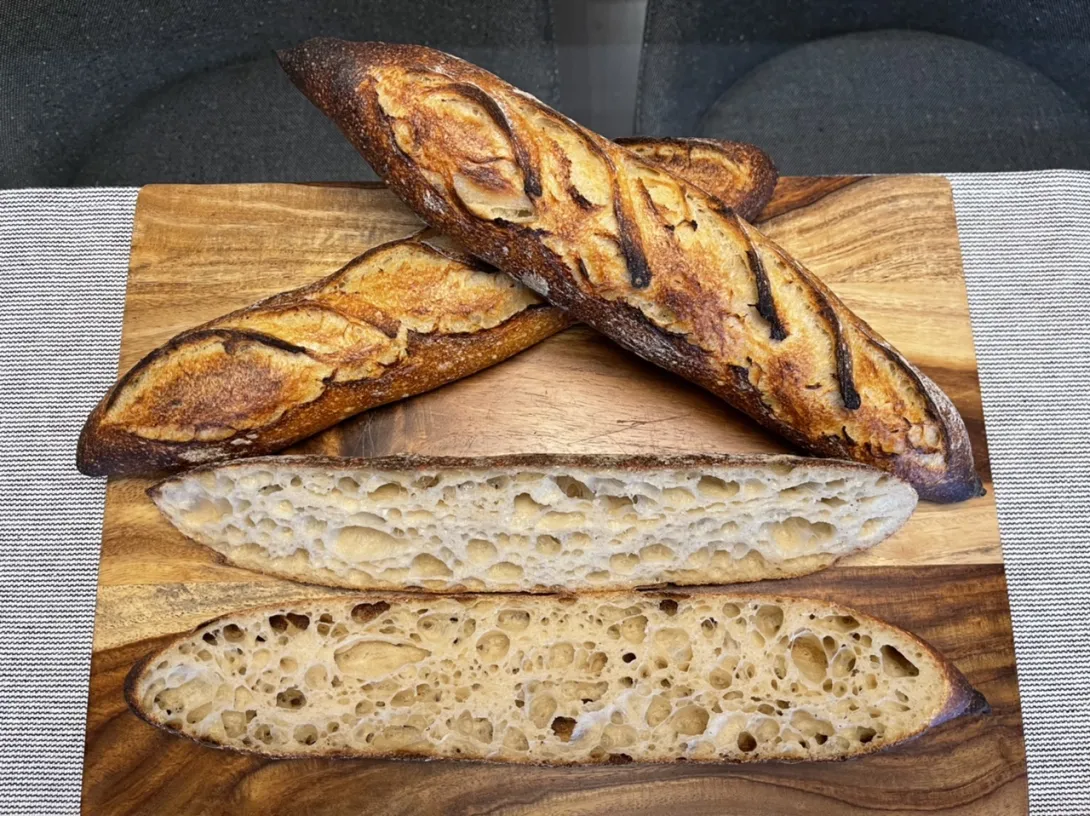
 IMG_16021920×1003 190 KB
IMG_16021920×1003 190 KB
Overnight levain
18 g starter + 16 g white sugar + 23 g water + AP flour 51 g. 78°F
Fermentolyse - mix 378 g water with all the levain, salt 11 g and diastatic malt 5.7 g to dissolve, then add 521 g AP flour to combine. Slap and fold x 100 then add hold back water 23 g gradually working in until fully absorbed then slap and fold x 100.
Bulk Fermentation 82*F until aliquot jar shows 20% rise.
Do folds every 30 mins doing 2-3 folds
Could do cold retard at this point for up to overnight. (Aliquot jar 20% rise)
Divide and pre-shape rest for 15 mins
Shape en couche with final proof until aliquot jar shows 35% rise then cold retard shaped baguettes en couche for at least 15 minutes for easier scoring.
Pre-heat oven 500F after 30 mins add Silvia towel
Transfer to peel on parchment
Score each baguette and transfer to oven bake on steel
Bake with steam pouring 1 cup of boiling water to cast iron skillet dropping temperature to 480F
The baguettes are baked with steam for 13 mins. The steam equipment is removed venting the oven of steam. Transfer the baguettes from the baking steel to next rack completing baking directly on a rack to minimize the browning of the bottom crust. The oven is left at 480ºF but convection is turned on and the baguettes bake for 10 mins rotating them halfway. The oven temperature is then dropped to 450ºF and the baguettes rotated again if needed and baked for another 3 mins to achieve a rich colour crust.
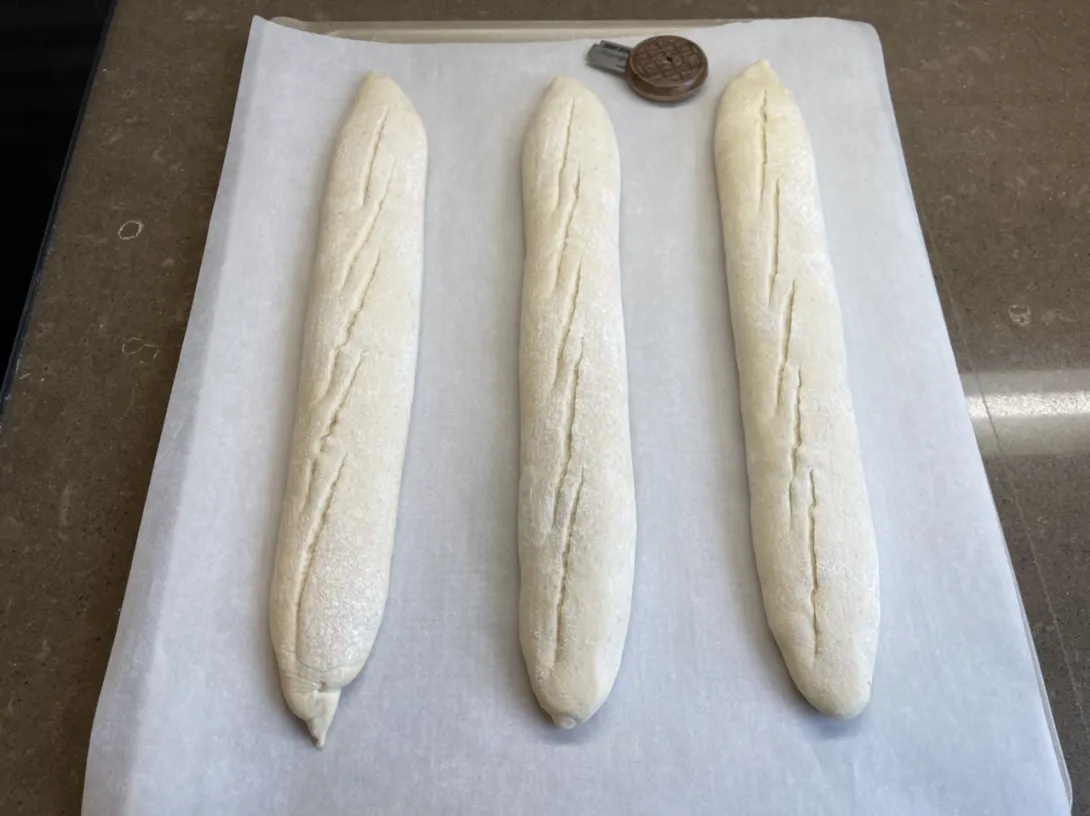


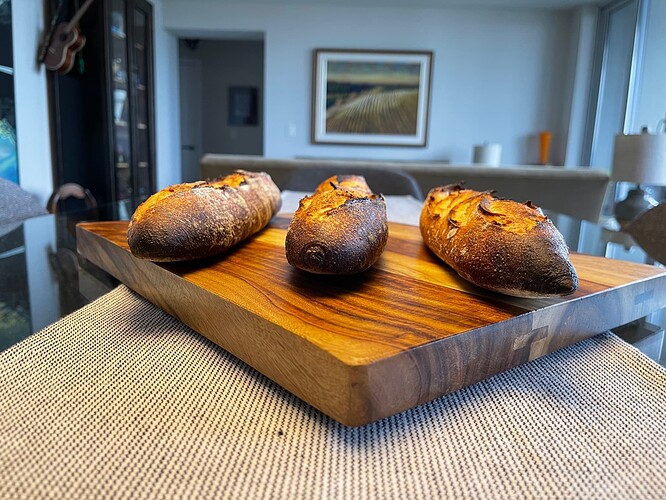
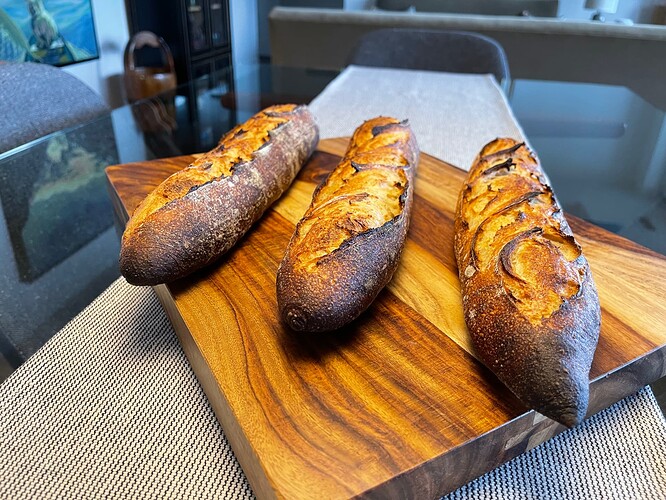
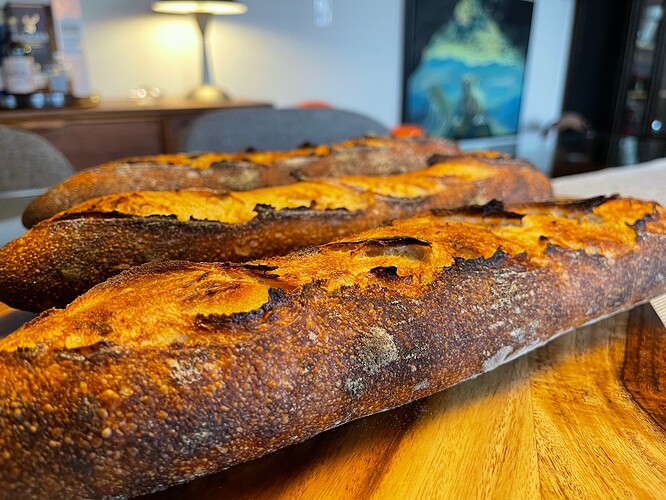
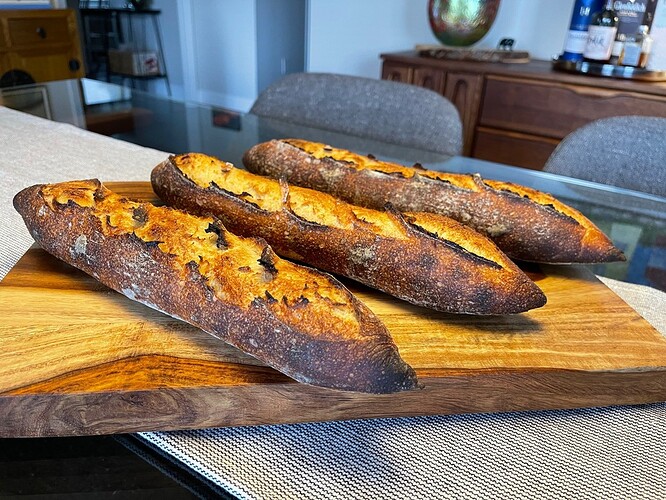
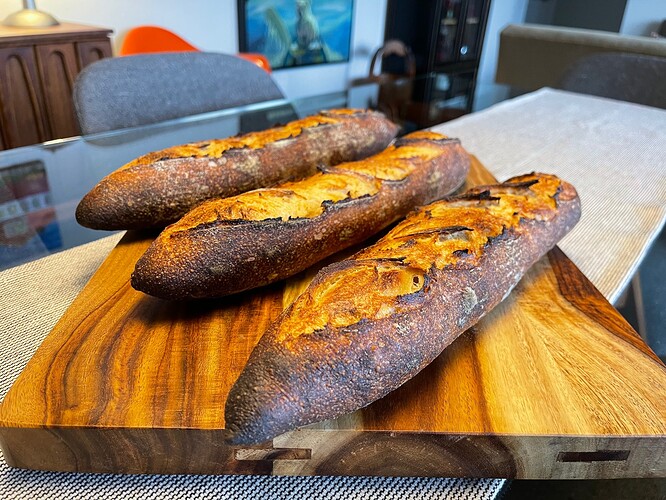
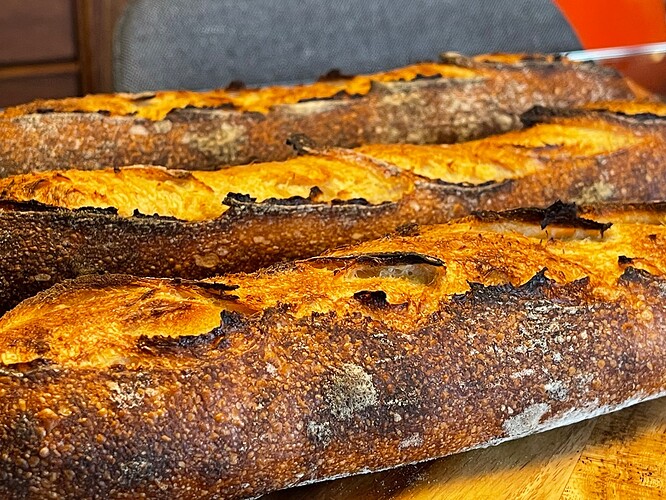 I’m not mad at the broken straps, I’ll take those for great bloom any day.
I’m not mad at the broken straps, I’ll take those for great bloom any day.
- Benito's Blog
- Log in or register to post comments
Here’s a diagram for scoring.
Imagine your baguette divided longitudinally into three lanes approximately equal widths. Your scores should stay in that middle lane. Ideally each score should overlap with the next by about ¼ to ⅓. If they don’t overlap the baguette will end up sausage link shaped with lobes. Your blade should be angled at about 30-45* from the surface of the dough. This will give you nice ears.
No, I want the whole shebang with my baguettes, the good-looking earflaps, the bloom, the roundness, everything, is that too much to ask? Why are your AP baguettes so dark Doc? Can't wait to see a crumb shot.........
Crumb photos are now posted.
There is some sugar in the levain which will then be in the dough and that would in part be why they are dark. But the real answer to your query is that I like my bread with a dark bake Ming!
Benny
I see. Very nice open crumb, that is beauty in the beast :), great bake Doc. Thanks.
Thank you Ming.
Could also be the diastatic malt...
You're right Jon, the diastatic malt will also help with browning.
Very pleased with the crumb of these baguettes. Happy that my ideas about more gluten development early on and then building more tension during shaping have worked. So despite pushing final proofing further (in the past anything past 30% I would lose the grigne) I was able to get great bloom so the extent that the straps broke while still having an open crumb. I can push the hydration with this flour further and will do so next time perhaps to 76% hydration.
I mention the tension in the dough while shaping, I’ve switched shaping methods again and use Scott Megee’s shaping now. I have a video of my shaping using this method that I will post eventually. But I think it will be my go to shaping for baguettes going forward.
What an accomplishment, incroyable
Will have to google Scott McGee now.
Trying to figure out where the racks for the second half of the bake are. Above the baking steel, right?
-Jon
Thank you Jon, my oven unfortunately is smaller than standard NA ovens and only has two racks. So when I vent the oven and remove the steaming equipment I will bake a few minutes more to harden the crust a bit and then transfer the baguettes to the rack above the baking steel to try to lessen the browning of the bottom crust. I may try baking at a lower temperature next time. I've always baked at 480ºF but never tried at 450ºF for fear of losing that oven spring, but really 450ºF should be enough and may help reduce the extra browning from the presence of that extra sugar from the levain. I could also eliminate the diastatic malt when I use a stiff levain, that would be another adjustment I could try. There's always room for improvement and experimentation with bread isn't there?
Edited to add:
I'll be posting a new baguette scoring video. Now don't expect too much because I think it is only the second time doing the Scott Megee shaping so I am a bit more clumsy than even my usual. I'll have that up once it is ready.
Benny
Looking so forward to your vid, popcorn in the cupboard at the ready. In the mean time I googled Scott and found a vid of him shaping. Interesting technique, my first thought was that it wouldn't make an 'even' baguette, but rather something more lumpy. But it doesn't, and looks much easier than the shaping in all those French videos that involve a lot of dexterity and thousands of hours of practice.
Are your baguettes around 20cm or longer? Was in the appliance store on the weekend looking for a fridge but did take a wander past all these lovely wide ovens that can fit two dutch ovens side by side.
This post of yours has started me thinking.... A sweet stiff preferment might work with, you guessed it, YW!
Jon
OK I hope my video isn't too disappointing, I do look clumsy doing the tensioning of the dough. but I have to say that it works a charm. I think my steel is 16" in width so that is the maximum length of baguette I can bake. These were nice in that they didn't contract on the couche and kept their length nicely. All the tension is circumferential with this shaping, the downside might be the broken straps, changing the scoring a bit might help with that. Leaving the straps wider when scoring might make then strong enough to withstand the bloom that results from the tension in the dough. That'll have to be for another bake.
I'm not surprised that you're thinking of combining a yeast water with a stiff sweet levain. I think that is a nice way of getting a little bit of sour complexity without going whole hog on a typical 100% hydration levain.
Benny
The new shaping method seems to work better for getting ears and bloom without harming the crumb. Really nice batons maybe your best yet that I can recall. The slashes aren’t that difficult at room temp to require chilling for a man with your expertise. How does the sugar effect the taste and texture? Have the French baguette police been banging on your door? You better call dibs on the book title FWSSY
I noticed with the sweet levain breads I have made have a more open crumb so I guess sugar does cause cavities. It also has a longer keeping quality but yours probably won’t last long enough to find out.
Don
Thank you Don, Scott Megee shaping is my current favorite now having used it a couple of times. I’m seeing less of the dense lines of crumb that I sometimes see in my previous baguettes using the other shaping methods I’ve used. The small amount of sugar in the levain cannot be tasted in the baguettes. However, the decreased sourness is noticeable and I like it.
I’m thinking that the increase in dough development is helping with better bloom and allowing me to push fermentation further helping the crumb. I’m liking this and will continue to make changes for future baguette bakes along these lines. I’ve been using your higher hydration which has made a big difference for extensibility and now copying your broken straps as well!
FWSSY is a good idea, I’ll have to develop all the recipes to include a bit of sugar in the levain haha.
Benny
Oh I forgot to mention that the main reason I chilled the shaped dough was for convenience. The oven wasn’t ready in time for the baguettes to start baking, so they had a chill while the oven heated. I still prefer to score chilled dough though.
Really beautiful work. Interesting to follow your experiments with the sweet levain. Since I moved to IDY for a few months, I actually missed the complexity of sourdough a lot.
Haven't attempted baguettes since last Fall.
Hiw do you do your slap and folds without spraying flour water everywhere? I tried the technique and was wiping up for days. I think I went way to vigorous though. :)
Thank you very much David. I find unless I make baguettes every few months I start to lose any sense of confidence I had built up from previous bakes. I suppose using different shaping methods each time does help that, but it does help me discover what works well for me. Sounds like it is time for you to make baguettes again soon. Since you’re onto commercial yeasted breads if you haven’t made the Bouabsa baguettes yet you should do yourself a favour and make them.
I seldom spray flour, water or dough anywhere anymore when I do my slap and folds, I’ve done so many now that it isn’t messy anymore.
Benny
I’m going to give them a try. What would you say about the flavour and texture? I find yeast baguettes to have a softer sweeter crumb and don’t seem so heavy. I wonder if these would be similar?
I know what you mean about commercial yeast baguettes vs typical sourdough ones Glenn, I've always found that the SD ones have a thicker crust for some reason. Using the stiff sweet levain these are more complex in flavour than the commercial yeast ones but without the sour tang from SD, somewhere in between. I think because these brown much more quickly I can reduce the temperature of baking and possibly shorten the baking time and get a even thinner crust. As they were my partner felt they were the best baguettes I've made in recent memory. But there's always room for improvements aren't there?
Benny
For those who are interested, I’ve just posted my video showing how I pre-shaped, shaped and scored these baguettes. I started a new blog post so that it would be easy to find in the future but I’ll add that here as well.
They look great Benny. The yellow crust in the blooms is unique for an all AP flour.
Thank you Troy, I’d say the AP flour I use is probably about a T55-T65, it isn’t as white as my bread flour and is from an organic mill. This flour does make a good tasting and textured baguette. However, I haven’t had the pleasure of tasting real French T55-T65 flour in a baguette which is supposed to be so much better.
Benny
I know you use your aliquot jar but I have yet to give that a try. How long was your bulk ferment and how long was your final rise before baking?
Ian
At 82°F the bulk in total was 5 hour and 45 mins from the end of mixing to good gluten development with slap and folds to the start of cold retard. Cold retard at 3°C was a total of 17 hours. Once out of the fridge the time from when pre-shaping was completed to the shaped baguettes en couche going into the fridge to chill was 1 hour and 25 mins at room temperature. They had about 20-30 mins chill time while the oven was pre-heating. Hope that helps.
Benny
So 5hrs and 45 minutes including your hand mixing with slap and folds or was this the time total once your started your stretch and folds after your were done with your slap and folds?
So the 5 hours and 45 minutes started after I completed the slap and folds. Unfortunately I didn’t record the time that I added the levain to the water to break it down so bulk was in fact longer than 5 hours and 45 mins. So that timing was after the slap and folds were completed and doesn’t include the intensive hand dough development.
When I do David’s Formula my bulk is around 4 hours after the initial mix. I use my Ankarsum mixer which does a great job of mimicking hand mixing.